What Affects the Depth of the Human–Garden Relationship in Freely Accessible Urban Sensory Gardens with Therapeutic Features in Various Users?
Abstract
1. Introduction
1.1. The Importance of Sensor Gardens in Urban Space
1.2. The State of Knowledge of Human-Sensory Garden Interaction
2. Method and Scope
3. Results
3.1. Relationships between Users and Gardens with Sensory Features
3.2. Examples of Sensory Gardens That Allow for Deep Garden-User Relationships
| Multidimensional Garden-User Relationships Based on Observed Behaviors | Cases of Sensory Gardens | Applied Specific Solutions (Attributes) to Enable a Deeper Relationship with the Garden | Senses Involved in Receiving the Garden (Leading Senses—Thick Font) |
|---|---|---|---|
| (1) Relationship with a sensory garden space as experienced by a child at play |
|
| CHILDREN: sight, touch, hearingGUARDIANS: taste, smell, sight |
|
| CHILDREN: touch, hearing, sight, spatial orientation GUARDIANS: no special sensory elements for this group | |
|
| CHILDREN: touch, hearing, sight GUARDIANS: no special sensory elements for this group | |
|
| hearing, sight, touch | |
| (2) Interactions with the garden of a participant in horticulture and gardening classes |
|
| touch, smell, sight, hearing, taste |
|
| touch, sight, smell, hearing | |
| (3) Relationships with a garden space as experienced by a garden café or restaurant user present in its vicinity |
|
| taste, smell, sight, hearing, touch |
|
| taste, smell, hearing, sight, touch | |
| (4) Relationships with a garden as experienced by a person who paused for longer in a specific interior of sensory garden |
|
| touch, hearing, smell, sight |
|
| hearing, sight, touch | |
|
| hearing, sight, touch, smell | |
| (5) Interaction with the garden of a person who passes through the interior or a path that strongly nourishes the senses |
|
| sight, touch or sight, smell, hearing, touch |
|
| smell, sight, touch | |
|
| sight, hearing or sight, hearing, touch | |
|
| sight, hearing, smell | |
|
| sight, smell, spatial orientation, touch, hearing | |
|
| sight, hearing or hearing, sight |
3.3. Users of Urban Sensory Gardens
4. Discussion
4.1. The Depth of the Garden–User Relations—Design Guidelines and the Significance of Sense Groups Involved in Garden Perception
4.2. Adaptation of the Urban Sensory Garden for Specific Users
5. Conclusions
- -
- It offers new ways of researching both existing gardens and emerging garden projects, apart from the most commonly used survey method.
- -
- It highlights the need to specify in detail the recipients of urban sensory gardens, both when conducting research on existing gardens and in the design process. Among them will be residents of the city of different ages and with different needs, people working in the city, as well as tourists.
- -
- It gives examples of groups of attributes that can be used in sensory gardens, which allow establishing deeper relationships between the garden and the recipient.
- -
- It draws attention to the groups of senses we call “leading senses”, which, when stimulated in a given garden interior, allow for the establishment of deep garden–recipient relationships.
Author Contributions
Funding
Institutional Review Board Statement
Informed Consent Statement
Data Availability Statement
Conflicts of Interest
References
- Harasimowicz, A. Green spaces as a part of the city structure. Econ. Environ. 2018, 65, 45–62. [Google Scholar]
- Haq, S.M.A. Urban Green Spaces and an Integrative Approach to Sustainable Environment. J. Environ. Prot. 2011, 2, 601–608. [Google Scholar] [CrossRef]
- Ulrich, R.S. Health Benefits for Gardens in Hospitals. In Proceedings of the Plants for People, International Exhibition Floriade, Haarlemmemeer, The Netherlands, 6 April–20 October 2002; pp. 1–10. [Google Scholar]
- Houlden, V.; Scott, W.; de Albuquerque, J.; Javris, S.; Rees, K. The relationship between greenspace and the mental wellbeing of adults: A systematic review. PLoS ONE 2018, 13, e0203000. [Google Scholar] [CrossRef]
- Alock, I.; White, M.P.; Wheeler, B.W.; Fleming, L.E.; Depeledge, M.H. Longitudinal Effects on Mental Health of Moving to Greener and Less Green Urban Areas. Environ. Sci. Technol. 2014, 48, 1247–1255. [Google Scholar] [CrossRef]
- van den Berg, A.; Maas, J.; Verheij, R.A.; Groenewegen, P.P. Green space as a buffer between stressful life events and health. Soc. Sci. Med. 2010, 70, 1203–1210. [Google Scholar] [CrossRef]
- Grahn, P.; Stigsdotter, U. Landscape planning and stress. Urban For. Urban Green. 2003, 2, 1–18. [Google Scholar] [CrossRef]
- Kanelli, A.A.; Dimitrakopoulos, P.G.; Fyllas, N.M.; Chrousos, G.P.; Kalantzi, O.-I. Engaging the Senses: The Association of Urban Green Space with General Health and Well-Being in Urban Residents. Sustainability 2021, 13, 7322. [Google Scholar] [CrossRef]
- Wilson, E.O. Biophilia; Harvard University Press: Cambridge, MA, USA, 1984. [Google Scholar]
- Wintherbottom, D.; Wagenfeld, A. Therapeutic Gardens: Design for Healing Spaces; Timber Press: Portand, OR, USA, 2015. [Google Scholar]
- Krzeptowska-Moszkowicz, I.; Moszkowicz, Ł.; Porada, K. Urban Sensory Gardens with Aromatic Herbs in the Light of Climate Change: Therapeutic Potential and Memory-Dependent Smell Impact on Human Wellbeing. Land 2022, 11, 760. [Google Scholar] [CrossRef]
- van den Berg, A.; Hartig, T.; Staats, H. Preference for Nature in Urbanized Societies: Stress, restoration, and the pursuit of sustainability. J. Soc. Issues 2007, 63, 79–96. [Google Scholar] [CrossRef]
- Hussein, H.; Omar, Z.; Ishak, S.A. Sensory Garden for an Inclusive Society. Asian J. Behav. Stud. 2016, 1, 33–43. [Google Scholar] [CrossRef]
- Franco, L.S.; Shanahan, D.F.; Fuller, R.A. A Review of the Benefits of Nature Experiences: More Than Meets the Eye. Int. J. Environ. Res. Public Health 2017, 14, 864. [Google Scholar] [CrossRef] [PubMed]
- Lohr, V.I.; Pearson-Mims, C.H. Children’s active and passive interactions with plants influence their attitudes and actions toward trees and gardening as adults. HortTechnology 2015, 15, 472–476. [Google Scholar] [CrossRef]
- Krzeptowska-Moszkowicz, I.; Moszkowicz, Ł.; Porada, K. Evolution of the Concept of Sensory Gardens in the Generally Accessible Space of a Large City: Analysis of Multiple Cases from Kraków (Poland) Using the Therapeutic Space Attribute Rating Method. Sustainability 2021, 13, 5904. [Google Scholar] [CrossRef]
- Zhang, T.; Liu, J.; Li, H. Restorative effects of multi-sensory perception in urban green space: A case study of urban park in Guangzhou, China. Int. J. Environ. Res. Public Health 2019, 16, 4943. [Google Scholar] [CrossRef] [PubMed]
- Zardini, M. Toward a sensorial urbanism. In Proceedings of the Ambiances in action/Ambiances en acte(s)—International Congress on Ambiances, Montreal, QC, Canada, 19–22 September 2012; pp. 1–26. [Google Scholar]
- Harries, B.; Chalmin-Pui, L.S.; Gatersleben, B.; Griffiths, A.; Ratcliffe, E. Designing a wellbeing garden’ a systematic review of design recommendations. Des. Health 2023, 7, 180–201. [Google Scholar] [CrossRef]
- Hussein, H. Sensory Garden in Special Schools: The issues, design and use. J. Des. Built Environ. 2009, 5, 77–95. [Google Scholar]
- Salisbury, K.V. Enhancing the Experiences of Blind and Visually Impaired Visitors in Botanical Gardens. Master Thesis, Faculty of the University of Delaware, Newark, DE, USA, 2000. Available online: http://udspace.udel.edu./server/spi/core/bitstream/8e079f9d-5bd9-4dfa-ab1c-93918aa03f73/content (accessed on 29 July 2023).
- Dąbski, M.; Dudkiewicz, M. Przystosowanie ogrodu dla niewidomego użytkownika na przykładzie ogrodów sensorycznych w Bolestraszycach, Bucharzewie i Powsinie. Teka Kom. Archit. Urban. Stud. Kraj. 2010, 6, 7–17. [Google Scholar]
- Zajadacz, A.; Lubarska, A. Sensory gardens as places for outdoor recreation adapted to the needs of people with visual impairments. Stud. Perieget. 2020, 30, 25–43. [Google Scholar] [CrossRef]
- Pawłowska, K. Ogród sensoryczny. In Dźwięk w Krajobrazie Jako Przedmiot Badań Interdyscyplinarnych, Prace Komisji Krajobrazu Kulturowego PTG, 11; Bernat, S., Ed.; Polihymnia: Lublin, Poland, 2008; pp. 143–152. [Google Scholar]
- Balode, L. The design guidelines for therapeutic sensory gardens. Res. Rural. Dev. 2013, 2, 114–119. [Google Scholar]
- Trojanowska, M. Parki i Ogrody Terapeutyczne; Wydawnictwo Naukowe PWN SA: Warszawa, Poland, 2017. [Google Scholar]
- Trojanowska, M. The Universal Pattern of Design for Therapeutic Parks. Methods of Use. Int. J. Sci. Eng. Res. 2018, 9, 1410–1413. [Google Scholar]
- Krzeptowska-Moszkowicz, I.; Moszkowicz, Ł.; Porada, K. Znaczenie miejskich ogrodów sensorycznych o cechach przyjaznych organizmom rodzimym, na przykładzie dwóch przypadków z terenu dużych miast europejskich: Krakowa i Londynu. In Integracja Sztuki i Techniki w Architekturze i Urbanistyce; Wydawnictwa Uczelniane Uniwersytetu Technologiczno-Przyrodniczego: Bydgoszcz, Poland, 2020; T. 6/1; pp. 61–69. [Google Scholar]
- Zajadacz, A.; Lubarska, A. Ogrody Sensoryczne Jako Uniwersalne Miejsca Rekreacji Dostosowane Do Potrzeb Osób Niewidomych w Kontekście Relacji Człowiek-Środowisko; Bogucki Wydawnictwo Naukowe: Poznań, Poland, 2020. [Google Scholar]
- Wajchman-Świtalska, S.; Zajadacz, A.; Lubarska, A. Recreation and Therapy in Urban Forests—The Potential Use of Sensory Garden Solutions. Forests 2021, 12, 1402. [Google Scholar] [CrossRef]
- Staniewska, A. Obłędne ogrody. In Terapeutyczne Właściwości Krajobrazu Jako Podstawa Kompozycji Zespołów Szpitali Psychiatrycznych XIX i na Początku XX w; Wydawnictwo Politechniki Krakowskiej: Kraków, Poland, 2020. [Google Scholar]
- Staniewska, A. Gardens of Historic Mental Health Hospitals and their Potential Use for Green Therapy Purposes. Land 2022, 11, 1618. [Google Scholar] [CrossRef]
- Zajadacz, A.; Lubarska, A. Sensory gardens as a new form of urban green space in smart sustainable cities. Geogr. J. 2023, 94, 125–145. [Google Scholar] [CrossRef]
- Hussein, H.; Omar, Z.; Amano, J.; Zakaria, A. Therapeutic sensory simulation garden for a residential care facility, Nozomi-No-Sato, Japan. J. Archit. Plan. Constr. Manag. 2022, 12, 27–39. [Google Scholar]
- Elbasyoni, M.E.M.; Gammaz, S.A. A Qualitative Therapeutic Design Approach for Sensory Garden Design for People with Dementia. Civ. Eng. Archit. 2023, 11, 2110–2122. [Google Scholar] [CrossRef]
- Hussein, H. Affordances of Sensory Garden towards Learning and Self Development of Special Schooled Children. Int. J. Psychol. Stud. 2012, 4, 135–149. [Google Scholar] [CrossRef][Green Version]
- Stigsdotter, U.; Grahn, P. What Makes a Garden a Healing Garden? J. Ther. Hortic. 2002, 13, 60–69. [Google Scholar]
- Talal, M.L.; Santelmann, M.V.; Tilt, J.H. Urban park visitor preferences for vegetation—An on-site qualitative research study. Plants People Planet 2021, 3, 375–388. [Google Scholar] [CrossRef]
- Ulrich, R.S.; Simons, R.F.; Miles, M. Stress recovery during exposure to natural and urban environments. J. Environ. Psychol. 1991, 11, 201–230. [Google Scholar] [CrossRef]
- Coldwell, D.F.; Evans, K.L. Visits to urban green-space and the countryside associate with different components of mental well-being and are better predictors than perceived or actual local urbanisation intensity Do’s and don’t children’s experiences of the primary school playground. Landsc. Urban Plan. 2018, 175, 114–122. [Google Scholar] [CrossRef]
- Moor, R.C. Compact Nature: The Role of Playing and Learning Gardens on Children’s Lives. J. Ther. Hortic. 1996, 8, 72–82. [Google Scholar]
- Thomson, S. Do’s and don’ts: Children’s experiences of the primary school playground. Environ. Educ. Res. 2007, 13, 487–500. [Google Scholar] [CrossRef]
- Barratt Hacking, E.; Hacking, R.J.; Scott, W. Engaging Children: Research Issues around Participation and Environmental Learning. Environ. Educ. Res. 2007, 13, 52–544. [Google Scholar] [CrossRef]
- Kohlleppel, T.; Bradley, J.; Jacob, S. A Walk through the Garden: Can a Visit to a Botanic Garden Reduce Stress? HortTechnology 2002, 12, 489–492. [Google Scholar] [CrossRef]
- Carrus, G.; Scopelliti, M.; Panno, A.; Lafortezza, R.; Colanelo, G.; Pirchio, S.; Ferrini, F.; Salbitano, F.; Agrimi, M.; Portoghesi, L.; et al. A Different Way to Stay in Touch with ‘Urban Nature”: The Perceived Restorative Qualities of Botanical Gardens. Front. Psychol. 2017, 8, 914. [Google Scholar] [CrossRef]
- Dyg, P.M.; Wistoft, K. Wellbeing in school garden—The case of the Garden for Bellies food and environmental education program. Environ. Educ. Res. 2018, 24, 1177–1191. [Google Scholar]
- Pawłowska, K. Dźwięk w krajobrazie jako przedmiot badań i środek wyrazu w sztuce ogrodowej i architekturze krajobrazu. Pr. Kult. 2012, XIII, 31–56. [Google Scholar]
- Hussein, H. Using the sensory garden as a tool to enhance the educational development and social interaction of children with special needs. Support Learn. 2010, 25, 25–31. [Google Scholar] [CrossRef]
- Terkenli, T.S.; Bell, S.; Živojinović, I.; Tomićević-Dubljević, J.; Panagopoulos, T.; Straupe, I.; Toskovic, O.; Kristianova, K.; Straigyte, L.; O’Brien, L. Recreational Use of Urban Green Infrastructure: The Tourist’s Perspective. In The Urban Forest Cultivating Green Infrastructure for People and the Environment; Springer: Berlin/Heidelberg, Germany, 2017; pp. 191–216. [Google Scholar]
- Agapito, D.; Pinto, P.; Mendes, J. Tourists’ memories, sensory impressions and loyalty: In loco and post-visit study in Southwest Portugal. Tour. Manag. 2017, 58, 108–118. [Google Scholar] [CrossRef]
- Buckley, R.C.; Cooper, M.-A. Tourism as a Tool in Nature-Based Mental Health: Progress and Prospects Post-Pandemic. Int. J. Environ. Res. Public Health 2022, 19, 13112. [Google Scholar] [CrossRef]
- Shao, M.; Lin, D. A Study on How the Five Senses Are Affected When Tourists Experience Towns with Forest Characteristics: An Empirical Analysis Based on the Data of Fujian, Guangdong and Sichuan in China. Sustainability 2021, 13, 8283. [Google Scholar] [CrossRef]
- Fusté-Forné, F.; Fusté-Forné, M. Urban Gardens as Sustainable Attractions for children in Family Tourism. Resources 2021, 10, 111. [Google Scholar] [CrossRef]
- He, M.; Wang, Y.; Wang, W.J.; Xie, Z. Therapeutic plant landscape design of urban forest parks on the Five Senses Theory: A case study of Stanley Park in Canada. Int. J. Geoheritage Parks 2022, 10, 97–112. [Google Scholar] [CrossRef]
- Chiesi, L.; Costa, P. Small Green Spaces in Dense Cities: An Exploratory Study of Perception and Use in Florence, Italy. Sustainability 2022, 14, 4105. [Google Scholar] [CrossRef]
- Krzeptowska-Moszkowicz, I.; Moszkowicz, Ł. Selected problems of Ailanthus altissima (Mill.) Swingle presence in urban spaces: The case of the city centre of Kraków. In Proceedings of the Plants in Urban Areas and Landscape, Nitra, Slovakia, 14–15 May 2014; pp. 56–62. [Google Scholar]
- Sudnik-Wojcikowska, B. The effect of temperature on the spatial diversity of urban flora. Phytocoen. Suppl. Cartogr. Geobot. 1998, 10, 97–105. [Google Scholar]
- Moszkowicz, Ł.; Krzeptowska-Moszkowicz, I. Impact of the public parks location in the city on the richness and diversity of herbaceous vascular plants on the example of Krakow Southern Poland. In Proceedings of the Plants in Urban areas and Landscape, Nitra, Slovakia, 7–8 November 2019; pp. 98–103. [Google Scholar]
- Moszkowicz, Ł.; Krzeptowska-Moszkowicz, I.; Porada, K. Relationship Between Parameters of Public Parks and Their Surroundings and the Richness, Diversity and Species Composition of Vascular Herbaceous Plants on the Example of Krakow in Central Europe. Landsc. Online 2021, 94, 1–16. [Google Scholar] [CrossRef]
- Sthapit, E. Memories of gastronomic experiences, savoured positive emotions and savouring processes. Scand. J. Hosp. Tour. 2017, 19, 1–25. [Google Scholar] [CrossRef]
- Zhang, J.; Li, D.; Ning, S.; Furuya, K. Sustainable Urban Green Blue Space (UGBS) and Public Participation: Integrating Multisensory Landscape Perception from Online Reviews. Land 2023, 12, 1360. [Google Scholar] [CrossRef]
- Waskul, D.; Vannini, P.; Wilson, J. The Aroma of Recollection: Olfaction, Nostalgia, and the Shaping of the Sensuous Self. Senses Soc. 2009, 4, 5–22. [Google Scholar] [CrossRef]
- Blomstervik, I.H.; Olsen, S.O. Progress on novelty in tourism: An integration of personality, attitudinal and emotional theoretical foundations. Tour. Manag. 2022, 93, 104574. [Google Scholar] [CrossRef]
- Westphal, J.M. Hype, Hyperbole, and Health: Therapeutic site design. In Urban Lifestyles: Spaces, Places People; Benson, J.F., Rowe, M.H., Eds.; Brookfield A. A. Balkema: Rotterdam, The Netherlands, 2000. [Google Scholar]
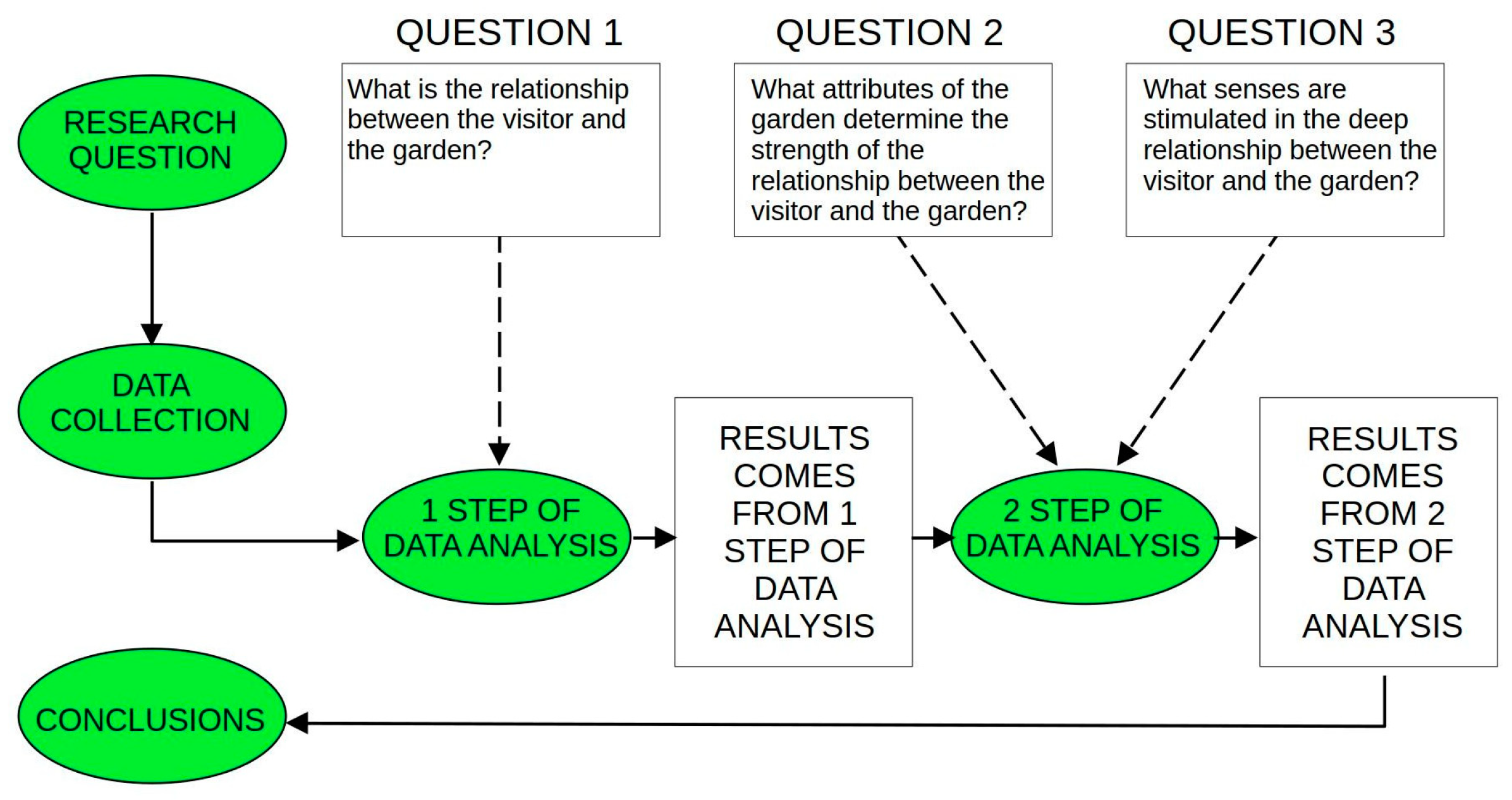
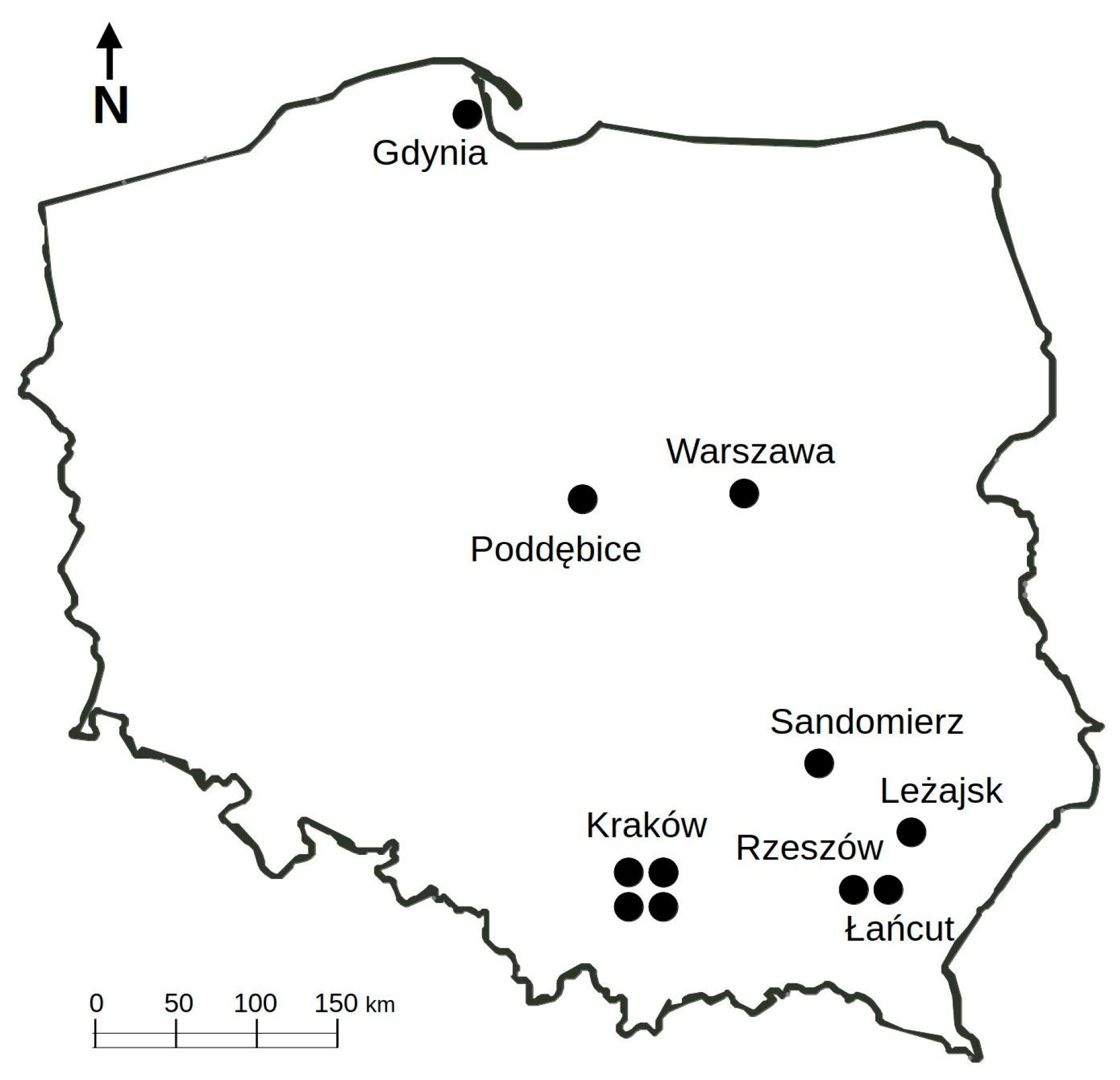

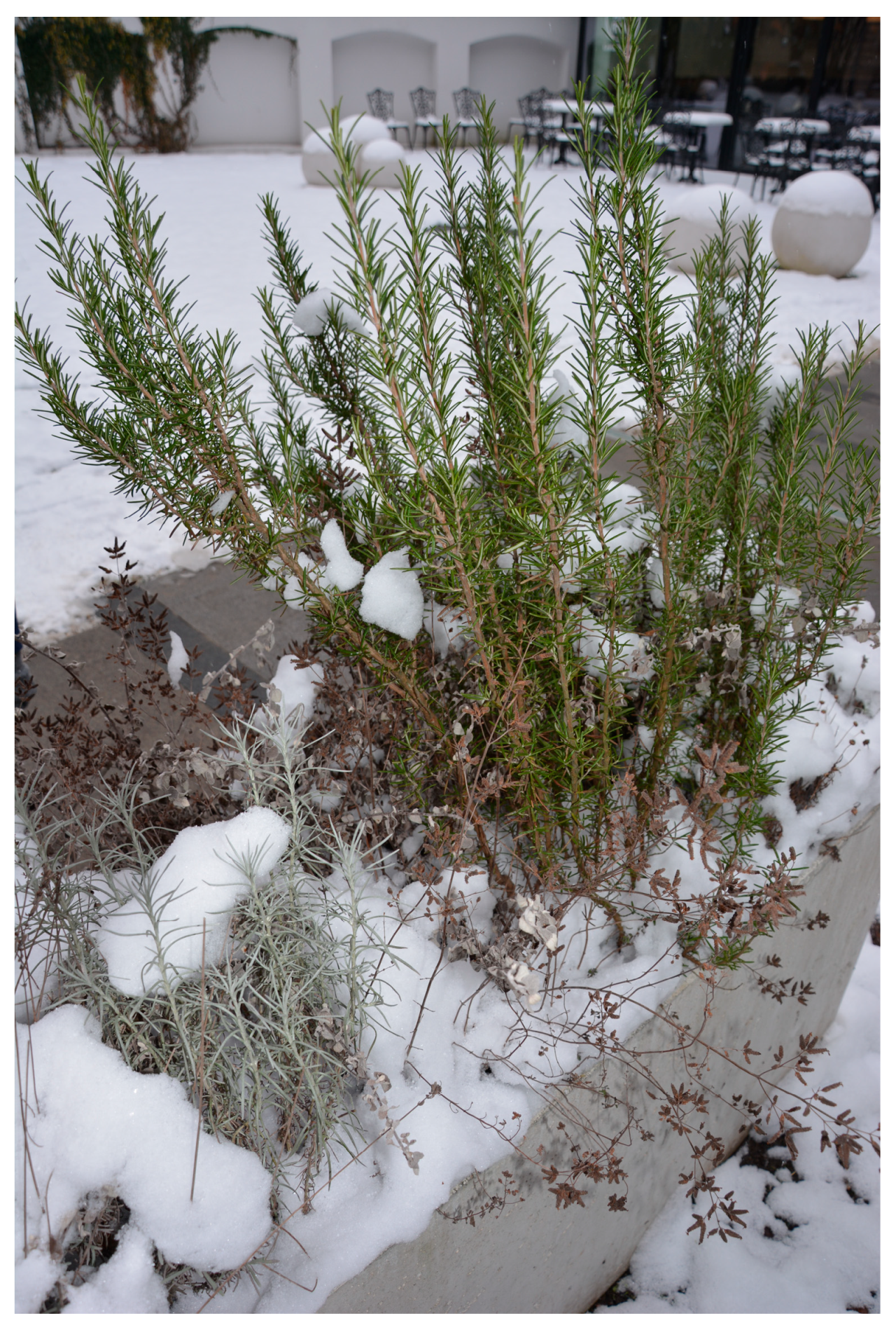
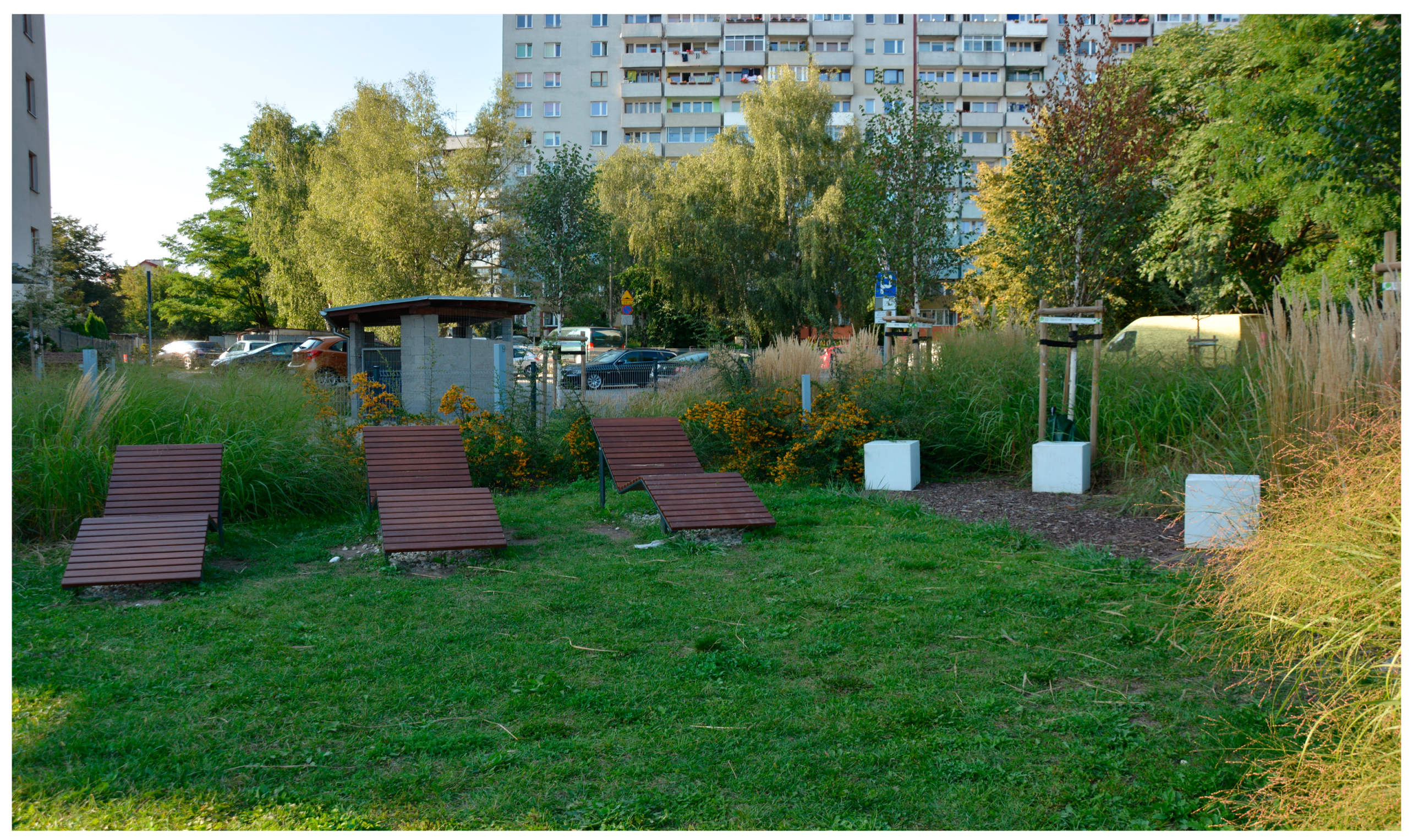
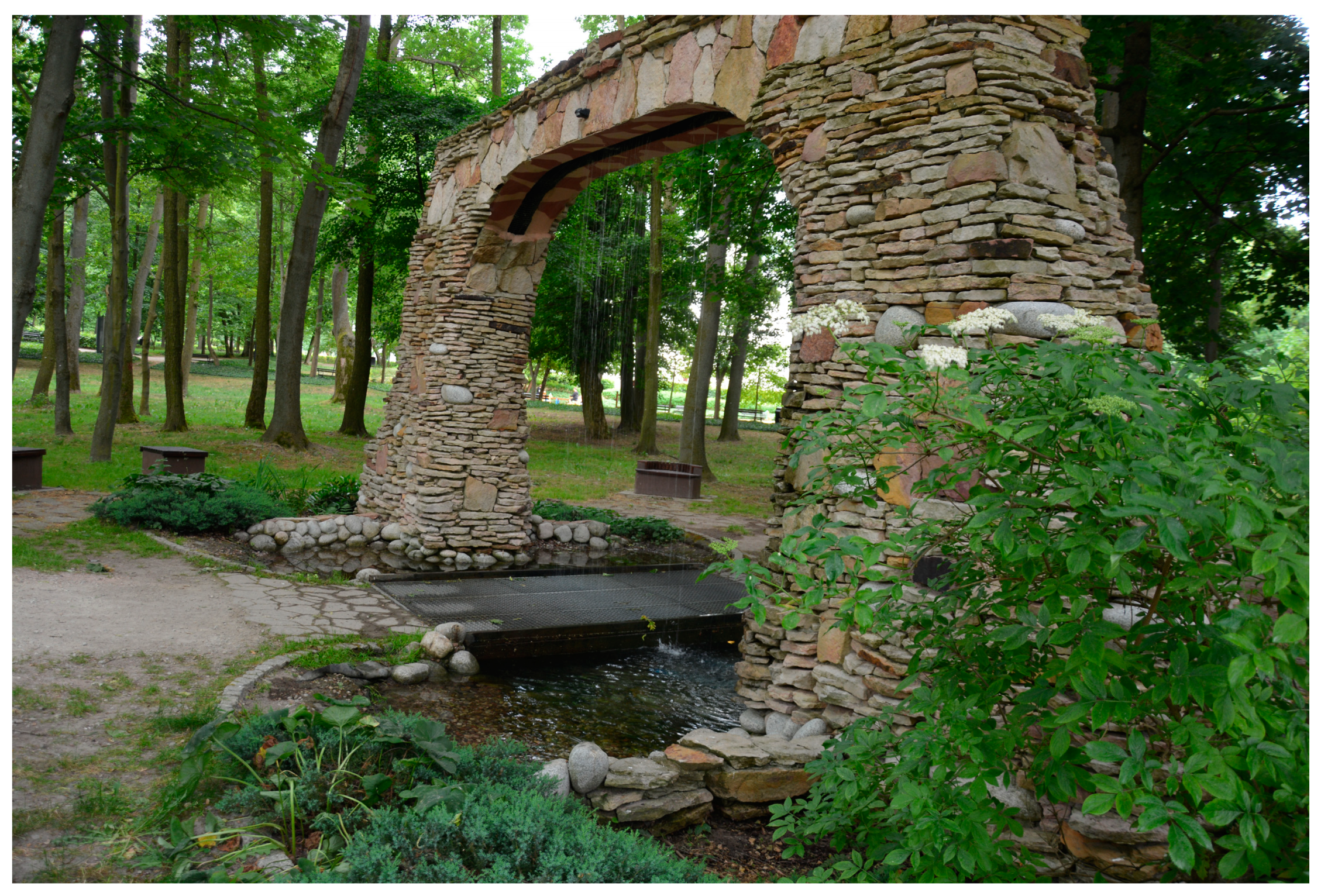
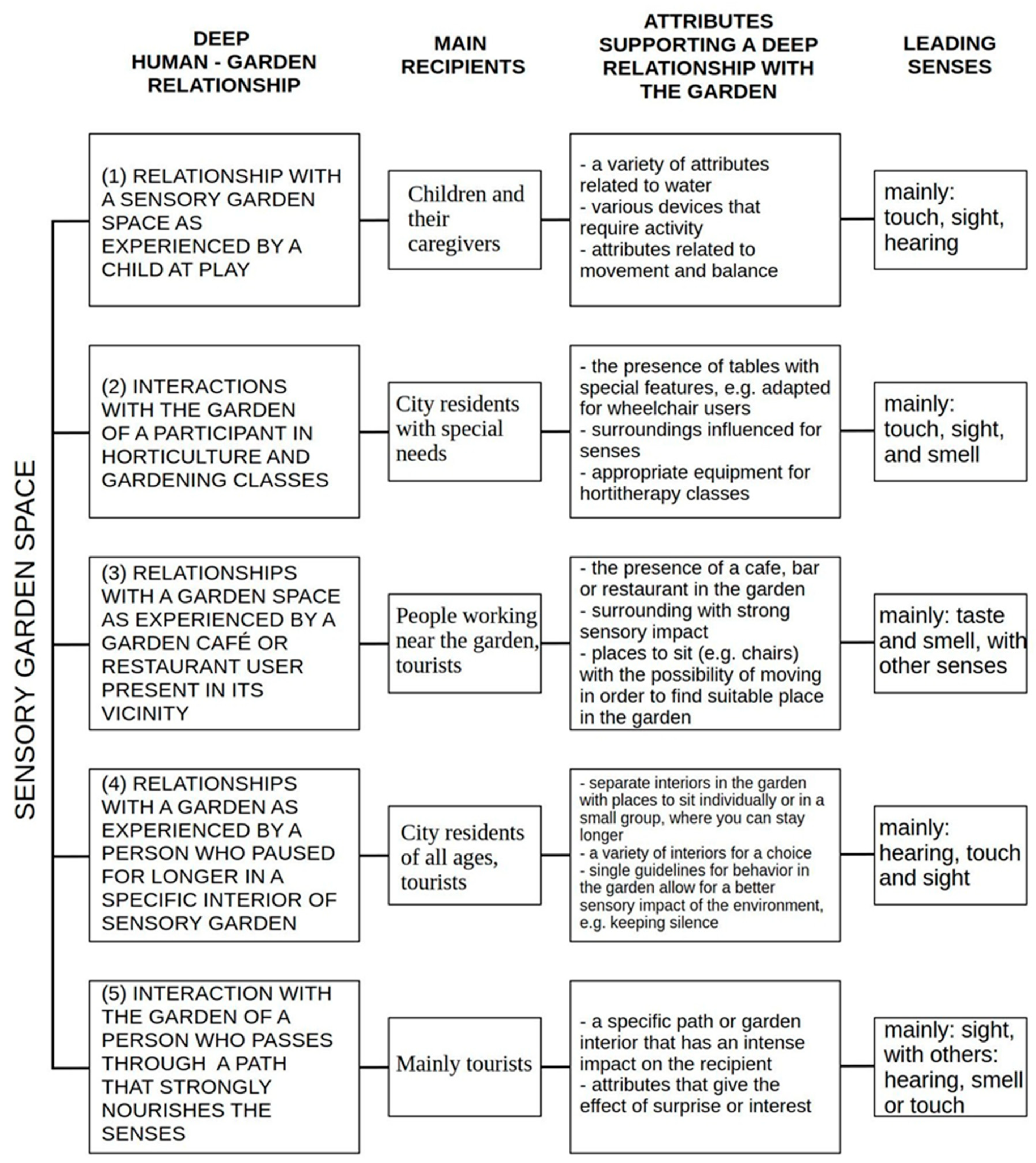
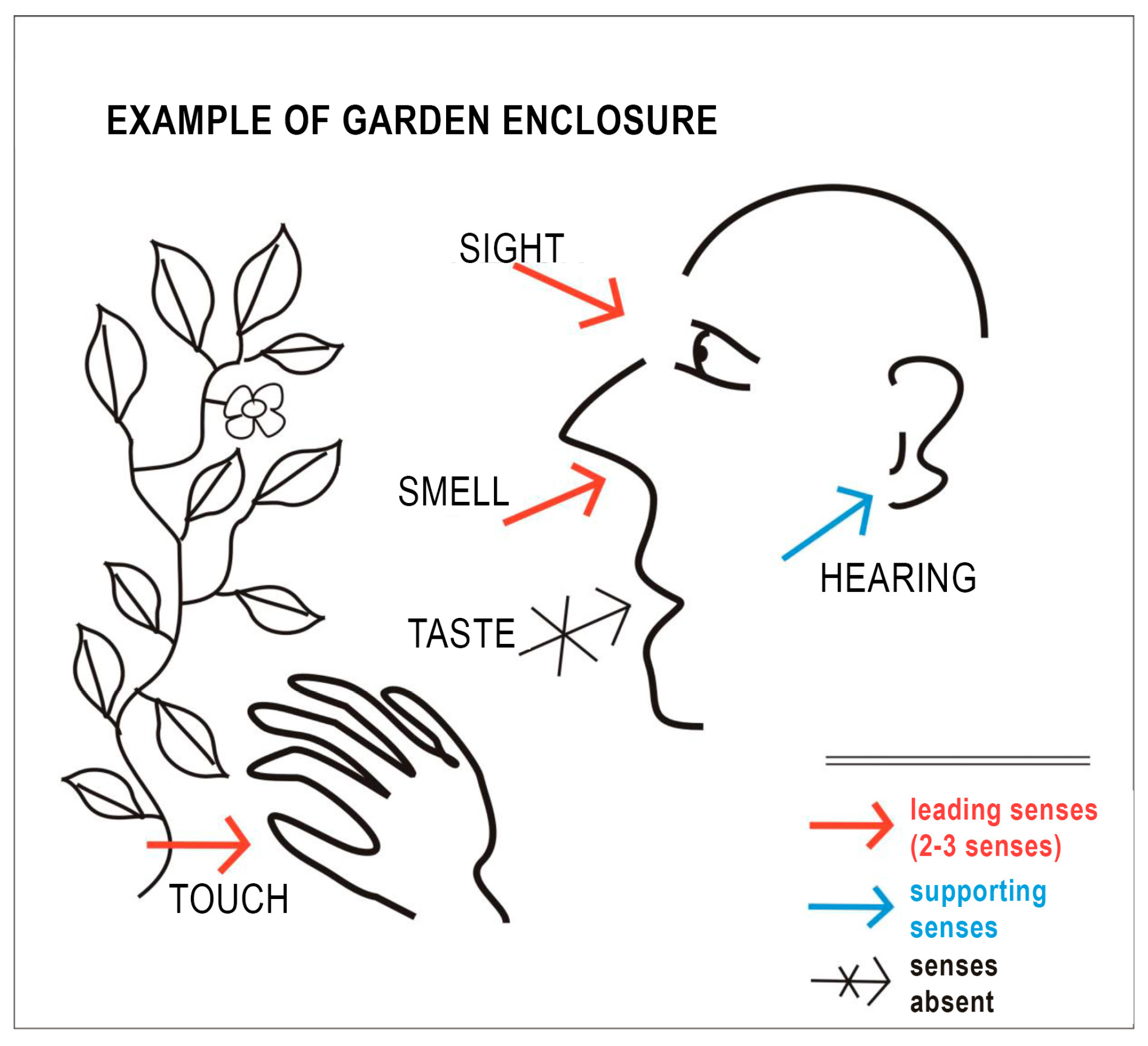
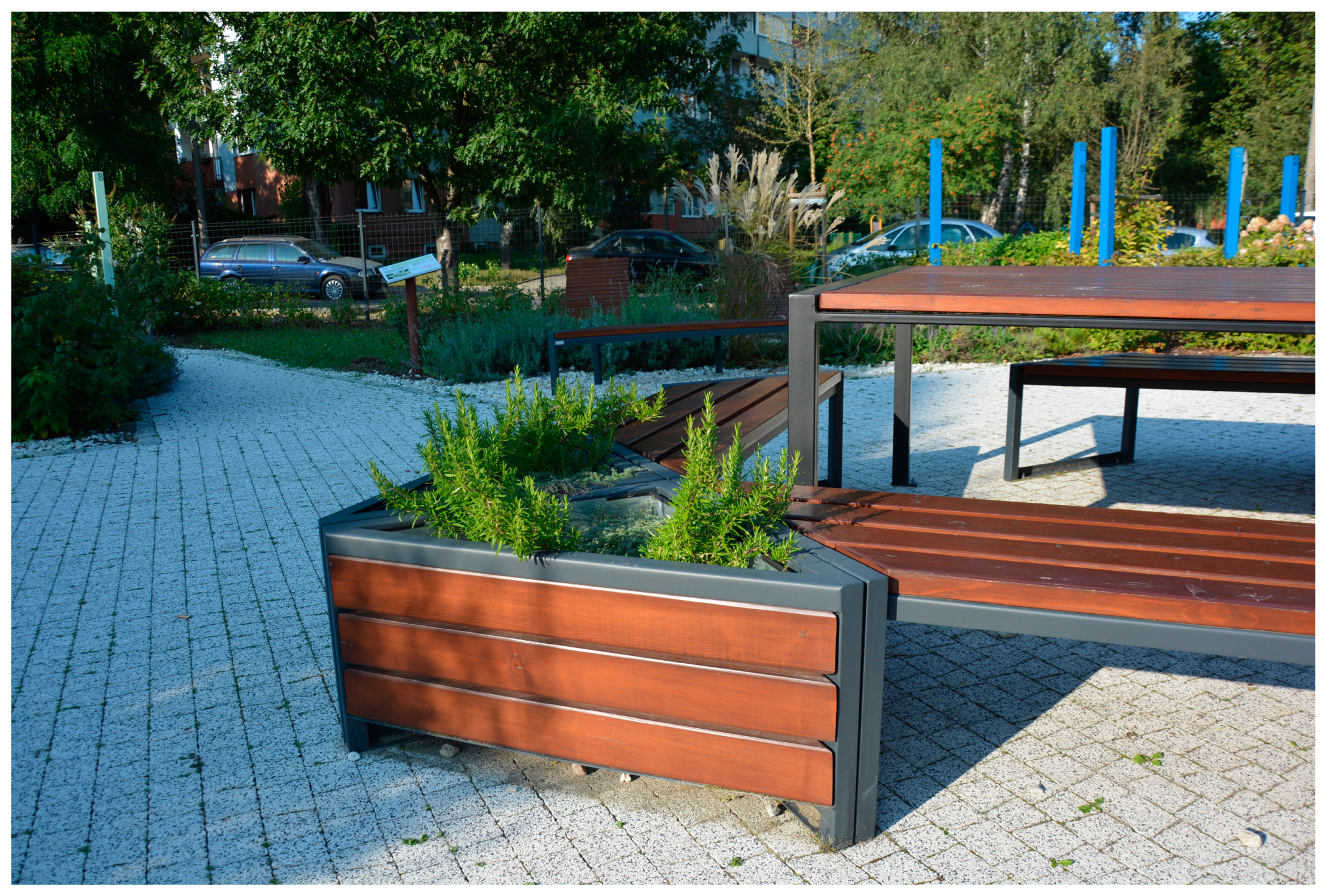
| Garden | Setting | Type of Nearest Neighborhood | Main Recipients | Features |
|---|---|---|---|---|
| A. Sensory Garden at the Franciscan Bernardine Center—LEŻAJSK (POLAND) | Church grounds | High compact fencing | Children and their caregivers—city residents, tourists | Very small garden, division into two enclosures, diversity of equipment |
| B. Children’s play garden with features of a sensory garden, Jordan Park—KRAKOW (POLAND) | Urban park | Green park surroundings | Children and their caregivers—city residents (children’s activity zone within the city green) | Division into different enclosures |
| C. Children’s play garden with sensory garden features, Royal Baths—WARSAW (POLAND) | Urban park | Green park surroundings | Children and their caregivers—city residents (children’s activity zone within the city green) | Variation of terrain in terms of relief |
| D. Gardens of the Bernardine Fathers with features of a sensory garden—RZESZÓW (POLAND) | Church grounds | Urban surroundings—streets, buildings | City residents of all ages, children, also tourists (sacred tourism zone, urban recreation zone) | Division into different enclosures |
| E. Sensory Garden in the Piaski Nowe housing estate—KRAKOW (POLAND) | Urban estate | Estate streets, high blocks of flats | The elderly—hortitherapy classes, residents of nearby blocks of flats (activity zone for residents of urban settlements) | Division into different enclosures and the division of space for each of the individual five senses |
| F. A garden with sensory garden features around Thrive headquarters, Battersea Park—LONDON (UK) | Urban park | Green park surroundings | City residents with special needs, especially young people—hortitherapy classes, the rest of the garden for other city residents and tourists (recreation zone within the urban greenery for residents and tourists, educational and therapeutic zone) | Flowerbeds with dense plantings, area for activities separated |
| G. Garden with the characteristics of a sensory garden at the J. Czapski Museum—KRAKOW (POLAND) | Area by the museum | Walls of tall buildings, a wall | Primarily tourists, people working in the city center but also residents, working or staying in the city center (urban tourism zone, museum education zone) | Small garden enclosure interacting with forms and subdued colors; plantings in high pots |
| H. Pocket garden—Paley Park—NEW YORK (USA) | Urbanized setting | Walls of tall buildings | People working near the garden, tourists (urban tourism zone, work activity zone) | Garden with terraces of varying heights, the dominant feature is a large waterfall |
| I. “Secluded Garden” sensory garden at the Royal Botanic Gardens, Kew—LONDON (UK) | Botanical garden | Green garden surroundings | Tourists, residents seeking relaxation in a garden setting (nature and museum education zone, urban recreation zone, urban tourism zone) | Garden with tall, dense plantings; diversity in terms of environmental features |
| J. Greenhouse in the park near the castle with strong sensory impact—Potocki Castle Museum—ŁAŃCUT (POLAND) | Park by the palace | Transparent greenhouse walls facing inwards—no view of the park | Tourists (urban tourism zone, nature education zone) | Dense greenery, water features, raised beds |
| K. Thyme path in the garden referring to the renaissance medical garden of Martin of Urzędów—SANDOMIERZ (POLAND) | Area by the museum | Urban environment—streets, buildings; green surroundings of the museum | Tourists (urban tourism zone, nature, and museum education zone) | Small geometric garden |
| L. Sensory garden in the public park—PODDĘBCE (POLAND) | Area in the urban park | Green park surroundings | Tourists, residents seeking relaxation in a garden setting (urban tourism zone within urban greenery, treatment zone—mineral water pump room) | Different enclosures surrounding by the greenery of the park |
| M. Garden of scents “Zapachowo” in the S. Lem Garden of Experiences—KRAKÓW (POLAND) | Area in the city park | Green park surroundings and educational surroundings | City residents, mainly children and youth (education zone, urban recreation zone) | Small garden in the form of a winding path surrounded by plants |
| N. Labyrinth of the senses on the “Alice trail” at the “Marszewo” Forest Botanical Garden—GDYNIA (POLAND) | Area in the city forest | Forest surroundings | City residents, mainly children and youth; tourists (education zone, urban recreation zone, tourism zone) | Garden in the form of a labyrinth with walls made of wood with pots filled with flowers |
| O. Music Garden—TORONTO (CANADA) | Urban green areas | The urban surroundings—streets, tall buildings, and the small harbor of Lake Ontario | Tourists, city residents (urban tourism zone, recreation zone within the urban greenery) | Diverse terrain in terms of relief, lots of different enclosures |
| Type of Relationship | Behaviors Observed | Brief Behavior Description | The senses Involved; Sequenced by Intensity of Stimulation |
|---|---|---|---|
| I. No relationship with the garden |
| ‘I will pass through quickly’ | None |
| II. Superficial reception of the garden |
| ‘I will enter, take a peek, and move on’ | Sight |
| III. Relationship with involuntary perception of the garden space |
| ‘I will enter and focus on what I am doing’ | Smell or sight or hearing |
| IV. Relationship with engagement |
| ‘I will enter and take a closer look at what the garden offers, but I want to quickly return to what I was doing previously’ | Touch, smell, sight, hearing, taste—either separately or jointly |
| V. Remaining in multidimensional relationships with the garden for some time |
| ‘I will play in this space and experience this garden, and use any elements that I might find’ | Various senses, between two and all five depending on the relationship type |
| ‘I will be here and engage in a garden-associated activity I am offered’ | ||
| ‘I will stay here, eat, or drink, and so engage the sense of taste, and absorb the environment with my other senses’ | ||
| ‘I will stay here and relax in a friendly sensory environment’ | ||
| ‘I will pass through this garden space and subject myself to intense sensory stimuli’ |
| Stimulus | Sense | Sense Depending on Stimulus Perception as Defined by McLinden and McCall [36] | Stimulus Perception by a User in a Sensory Garden |
|---|---|---|---|
| Images | Sight | distance sense | Typically passive—P |
| Sounds | Hearing | distance sense | Passive and active—P and A |
| Smells | Smell | distance sense | Passive and active—P and A |
| Surface structures | Touch | close sense | Typically active—A |
| Flavors | Taste | close sense | Active—A |
Disclaimer/Publisher’s Note: The statements, opinions and data contained in all publications are solely those of the individual author(s) and contributor(s) and not of MDPI and/or the editor(s). MDPI and/or the editor(s) disclaim responsibility for any injury to people or property resulting from any ideas, methods, instructions or products referred to in the content. |
© 2023 by the authors. Licensee MDPI, Basel, Switzerland. This article is an open access article distributed under the terms and conditions of the Creative Commons Attribution (CC BY) license (https://creativecommons.org/licenses/by/4.0/).
Share and Cite
Krzeptowska-Moszkowicz, I.; Moszkowicz, Ł.; Porada, K. What Affects the Depth of the Human–Garden Relationship in Freely Accessible Urban Sensory Gardens with Therapeutic Features in Various Users? Sustainability 2023, 15, 14420. https://doi.org/10.3390/su151914420
Krzeptowska-Moszkowicz I, Moszkowicz Ł, Porada K. What Affects the Depth of the Human–Garden Relationship in Freely Accessible Urban Sensory Gardens with Therapeutic Features in Various Users? Sustainability. 2023; 15(19):14420. https://doi.org/10.3390/su151914420
Chicago/Turabian StyleKrzeptowska-Moszkowicz, Izabela, Łukasz Moszkowicz, and Karolina Porada. 2023. "What Affects the Depth of the Human–Garden Relationship in Freely Accessible Urban Sensory Gardens with Therapeutic Features in Various Users?" Sustainability 15, no. 19: 14420. https://doi.org/10.3390/su151914420
APA StyleKrzeptowska-Moszkowicz, I., Moszkowicz, Ł., & Porada, K. (2023). What Affects the Depth of the Human–Garden Relationship in Freely Accessible Urban Sensory Gardens with Therapeutic Features in Various Users? Sustainability, 15(19), 14420. https://doi.org/10.3390/su151914420






